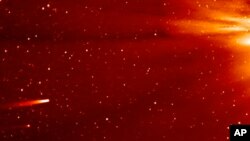CAPE CANAVERAL, FLORIDA —
The last vestiges of Comet ISON are fading from view after a sizzling close encounter with the sun, scientists said on Monday.
“Comet ISON is now just a cloud of dust,” astronomer Tony Phillips wrote on SpaceWeather.com, a NASA-backed website.
“Experienced astrophotographers might be able to capture the comet's fading 'ghost' in the pre-dawn sky of early December, but a naked-eye spectacle is out of the question,” he wrote.
Scientists believe the comet broke apart as it passed through the sun's corona on Thursday. At closest approach, the comet flew just 730,000 miles (1.2 million km) above the surface of the sun, a hair's breadth by astronomical measuring sticks.
The comet emerged from behind the sun “a remnant of its former self,” Phillips said.
For a couple of days, astronomers held out hope that a sliver of the comet's nucleus had survived and was brightening, but by Monday it was apparent ISON's brush with the sun was fatal.
“Comet ISON leaves behind an unprecedented legacy for astronomers, and the eternal gratitude of an enthralled global audience,” astrophysicist Karl Battams, with the Naval Research Laboratory in Washington D.C., wrote in a blog post titled “In Memoriam.”
The comet was discovered last year by two amateur astronomers using Russia's International Scientific Optical Network, or ISON.
Comets are believed to be frozen remains left over from the formation of the solar system some 4.5 billion years ago.
The family of comets that ISON was from resides in the Oort Cloud, which is located about 10,000 times farther away from the sun than Earth, halfway to the next star.
Computer models show ISON left the outer edge of the solar system about 5.5 million years ago and began journeying toward the sun.
“Never one to follow convention, ISON lived a dynamic and unpredictable life, alternating between periods of quiet reflection and violent outburst,” Battams wrote.
“Its toughened exterior belied a complex and delicate inner working that only now we are just beginning to understand,” he added.
“Comet ISON is now just a cloud of dust,” astronomer Tony Phillips wrote on SpaceWeather.com, a NASA-backed website.
“Experienced astrophotographers might be able to capture the comet's fading 'ghost' in the pre-dawn sky of early December, but a naked-eye spectacle is out of the question,” he wrote.
Scientists believe the comet broke apart as it passed through the sun's corona on Thursday. At closest approach, the comet flew just 730,000 miles (1.2 million km) above the surface of the sun, a hair's breadth by astronomical measuring sticks.
The comet emerged from behind the sun “a remnant of its former self,” Phillips said.
For a couple of days, astronomers held out hope that a sliver of the comet's nucleus had survived and was brightening, but by Monday it was apparent ISON's brush with the sun was fatal.
“Comet ISON leaves behind an unprecedented legacy for astronomers, and the eternal gratitude of an enthralled global audience,” astrophysicist Karl Battams, with the Naval Research Laboratory in Washington D.C., wrote in a blog post titled “In Memoriam.”
The comet was discovered last year by two amateur astronomers using Russia's International Scientific Optical Network, or ISON.
Comets are believed to be frozen remains left over from the formation of the solar system some 4.5 billion years ago.
The family of comets that ISON was from resides in the Oort Cloud, which is located about 10,000 times farther away from the sun than Earth, halfway to the next star.
Computer models show ISON left the outer edge of the solar system about 5.5 million years ago and began journeying toward the sun.
“Never one to follow convention, ISON lived a dynamic and unpredictable life, alternating between periods of quiet reflection and violent outburst,” Battams wrote.
“Its toughened exterior belied a complex and delicate inner working that only now we are just beginning to understand,” he added.








